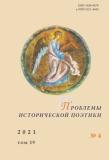Об одной эпитафии Димитрию Ростовскому (К истории жанра эпитафии в XVIII в.)
On an Epitaph to Dimitry of Rostov (on the History of the Epitaph’ Genre in the 18th Century)
Author(s): Marina A. FedotovaSubject(s): History of Church(es), Russian Literature, 17th Century, 18th Century, Eastern Orthodoxy, Philology
Published by: Петрозаводский государственный университет
Keywords: epitaph; baroque style; evolution of genres; iconography; hagiography; problems of attribution; source study; canonization; Dimitry of Rostov; Ioann Maksimovich;
Summary/Abstract: The article analyzes an epitaph dedicated to Dimitry of Rostov. It was written in Ukraine after the death of the metropolitan in 1709, but before his official canonization in 1757. Unlike the two other well-known epitaphs dedicated to Saint Dimitry (the funeral oration by Stephen Yavorsky and the inscription by Michail Lomonosov engraved on the silver icon case of his tomb complex), this text, which belongs to the syllabic epitaph genre, was an inscription under Dimitry’s lifetime portrait that was kept in the Novgorod-Seversky monastery. This epitaph, like the first two texts, can be clearly characterized as a baroque text, however, it differs significantly from them in content and style. It reflects other artistic phenomena of baroque poetics and has the features of synthesis, a combination of an iconographic image and signature, illustrations and text, words and images. The portrait-icon with verses was delivered to Rostov to metropolitan Arseny (Matseevich) through Fyodor Dubyansky, the confessor of Empress Elizabeth Petrovna. For a long time, it was preserved at the tomb of St. Dimitry in the interior of the Trinity (Conception) monastery. This epitaph reflects the Ukrainian tradition, in which portraits with epitaphs were hung at the graves of bishops and churchwardens. Who was the author of this epitaph to Dimitry of Rostov? It was most certainly a representative of the Ukrainian elite who knew Dimitry’s biography very well. Perhaps it was Ioann (Maksimovich), the future metropolitan of Tobolsk. The location of the original icon with the inscription is unknown, but a copy has survived in the museum of the KievPechersk monastery. However, this epitaph continued to exist in the written tradition. Several copies of it are known, and its text was reproduced and perceived separately from the iconographic model as a hagiographic text. It served, in turn, as a source of other such texts dedicated to Dimitry of Rostov and created after his canonization. The subsequent fate of this epitaph is also associated with the phenomena of the new cultural epoch, in which different types of art did not merely complement each other, but also led to the expansion of artistic expression, to the creation, interaction and interchangeability of new artistic forms, evolution of genre, which are undoubtedly important for the studying the genre poetics of the 18th century.
Journal: Проблемы исторической поэтики
- Issue Year: 19/2021
- Issue No: 4
- Page Range: 190-214
- Page Count: 25
- Language: Russian

